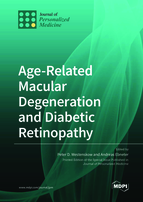Age-Related Macular Degeneration and Diabetic Retinopathy
A special issue of Journal of Personalized Medicine (ISSN 2075-4426). This special issue belongs to the section "Mechanisms of Diseases".
Deadline for manuscript submissions: closed (30 September 2021) | Viewed by 40867
Special Issue Editors
Interests: neurovascular interactions in the retina to prevent photoreceptor atrophy and vision loss; gene therapy; cellular engineering; advanced cell modeling; transgenics; multi-omics to examine pathomechanisms of age-related macular degeneration; diabetic retinopathy; glaucoma; complications stemming from each disease
Interests: ophthalmology; biomarkers; diabetic retinopathy; age-related macular degeneration; retinal vascular pathology; retinal vein occlusion; retinal pigment epithelium; selective retina therapy; neuroprotection
Special Issue Information
Dear Colleagues,
Age-related macular degeneration and diabetic retinopathy are leading causes of vision loss in industrialized countries. Vascular instability, impaired metabolism, neuronal dysfunction, and neurodegeneration are shared pathomechanisms. The Journal of Personalized Medicine is now opening a Special Issue devoted to basic and clinical research on this topic, and we issue a call for papers covering vascular stability, neurometabolism, biomarkers, and novel clinical approaches.
Dr. Peter D. Westenskow
Dr. Andreas Ebneter
Guest Editors
Manuscript Submission Information
Manuscripts should be submitted online at www.mdpi.com by registering and logging in to this website. Once you are registered, click here to go to the submission form. Manuscripts can be submitted until the deadline. All submissions that pass pre-check are peer-reviewed. Accepted papers will be published continuously in the journal (as soon as accepted) and will be listed together on the special issue website. Research articles, review articles as well as short communications are invited. For planned papers, a title and short abstract (about 100 words) can be sent to the Editorial Office for announcement on this website.
Submitted manuscripts should not have been published previously, nor be under consideration for publication elsewhere (except conference proceedings papers). All manuscripts are thoroughly refereed through a single-blind peer-review process. A guide for authors and other relevant information for submission of manuscripts is available on the Instructions for Authors page. Journal of Personalized Medicine is an international peer-reviewed open access monthly journal published by MDPI.
Please visit the Instructions for Authors page before submitting a manuscript. The Article Processing Charge (APC) for publication in this open access journal is 2600 CHF (Swiss Francs). Submitted papers should be well formatted and use good English. Authors may use MDPI's English editing service prior to publication or during author revisions.
Keywords
- photoreceptor homeostasis
- neuroprotection
- vascular stability
- signaling pathways
- neurometabolism and hypoxia/ischemia
- biomarkers
- anti-VEGF approaches
- revascularization
- imaging tools







